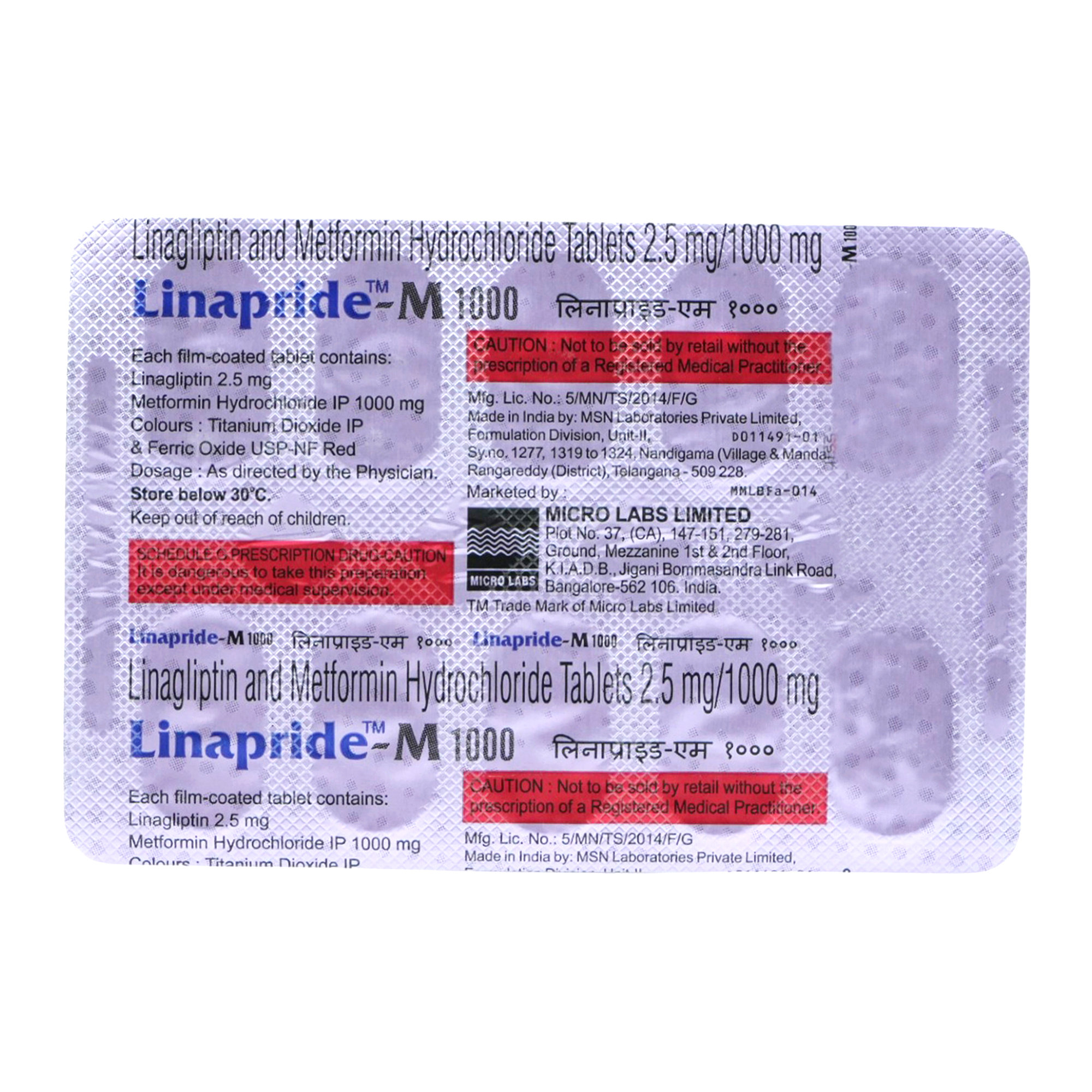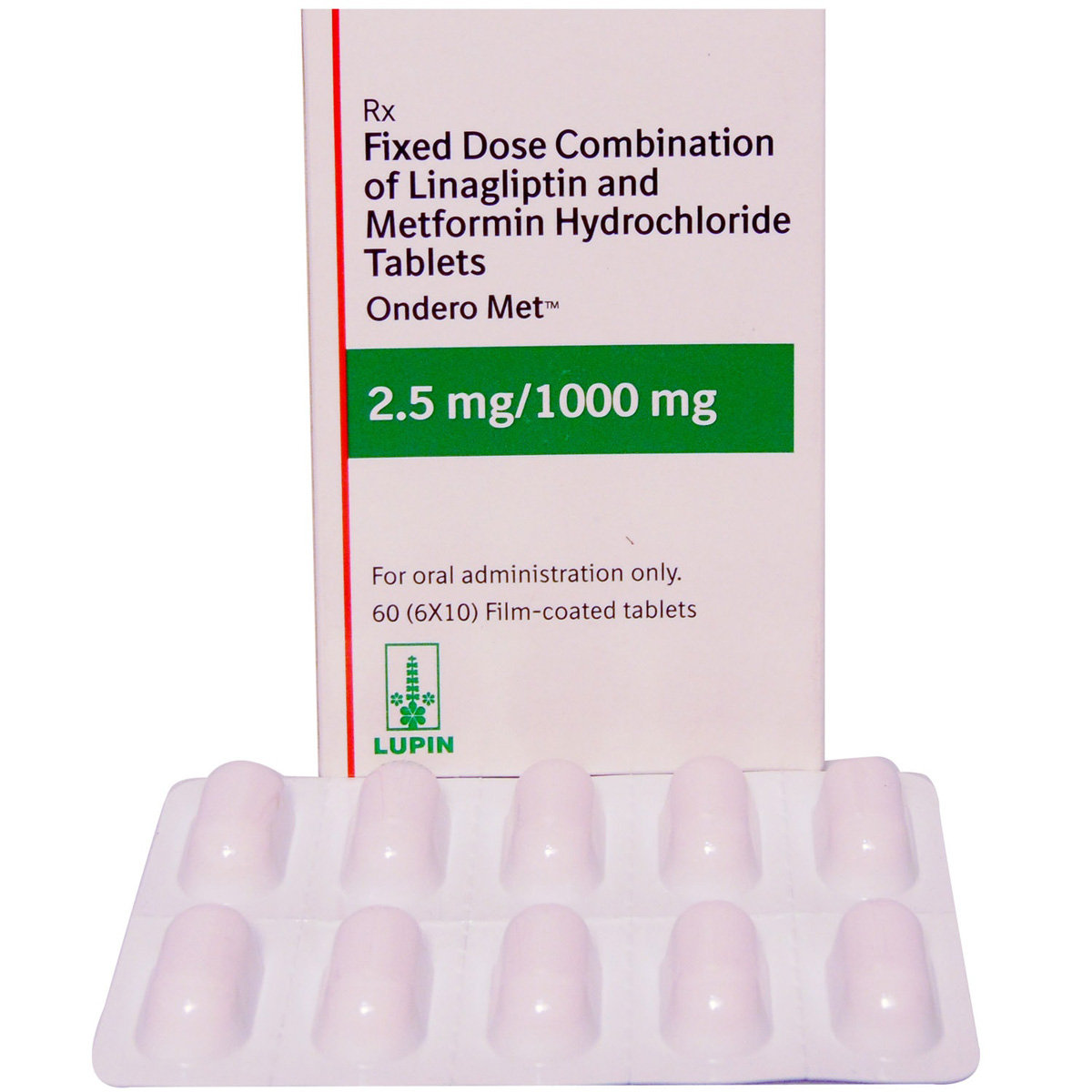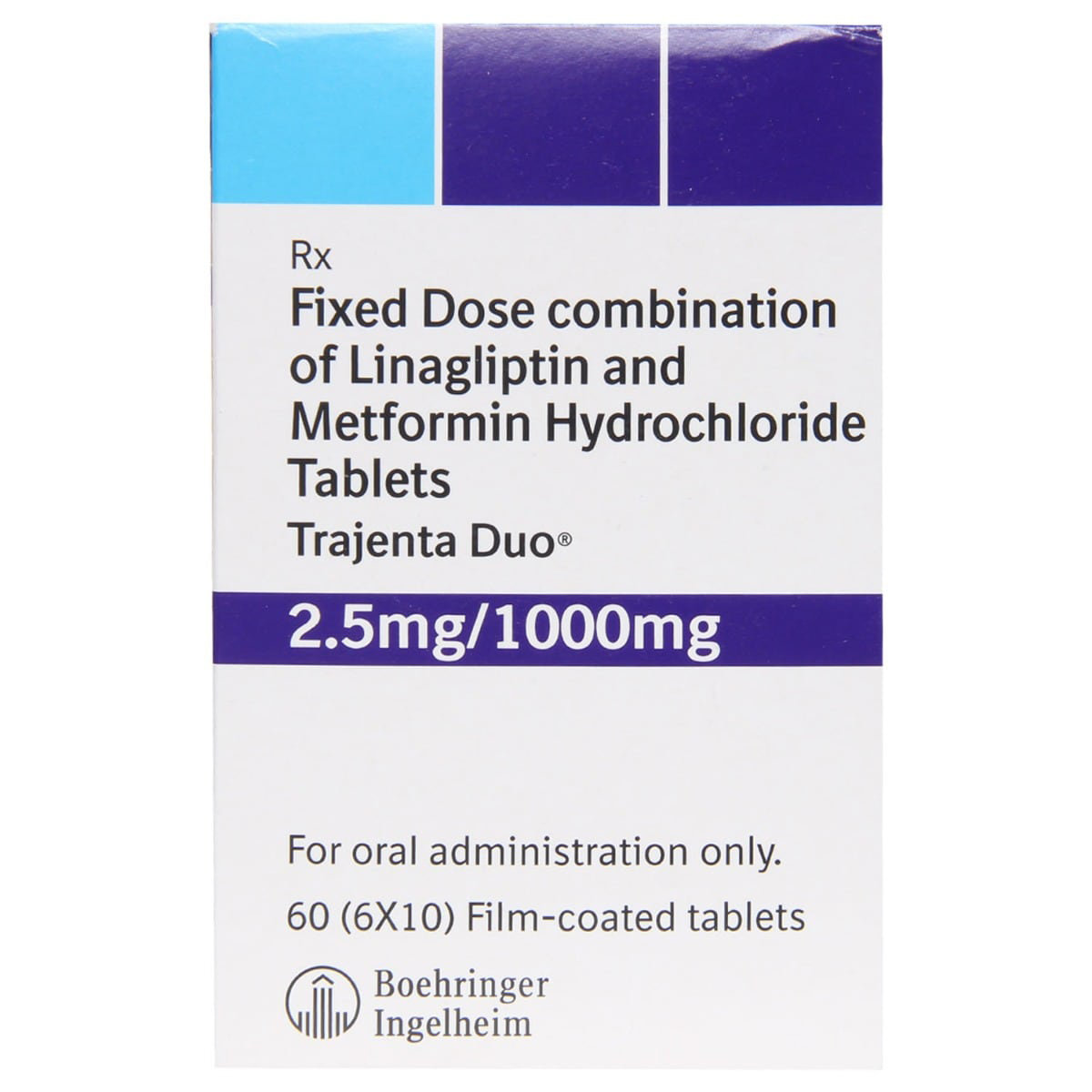Linanat-M 2.5 mg/1000 mg Tablet 10's
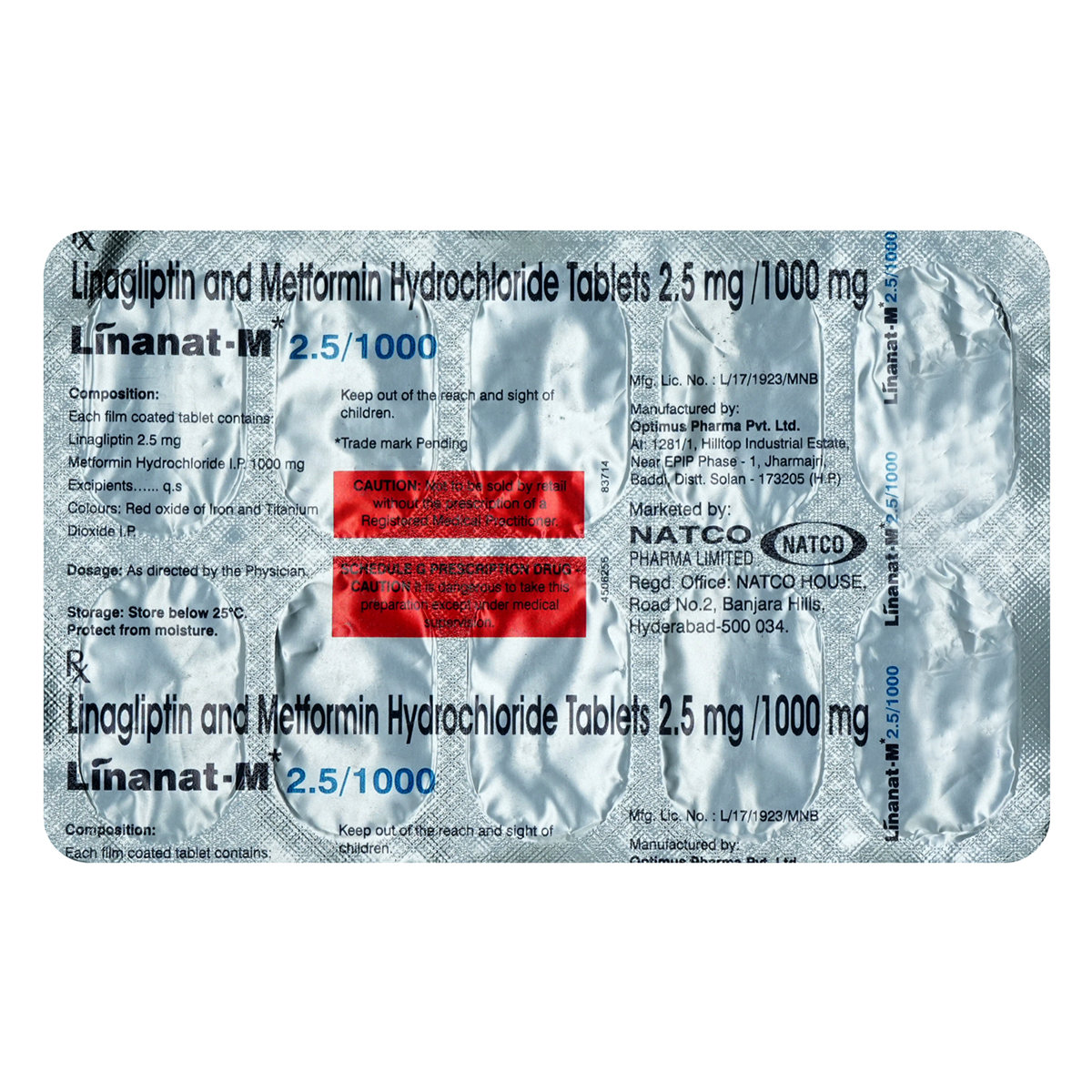
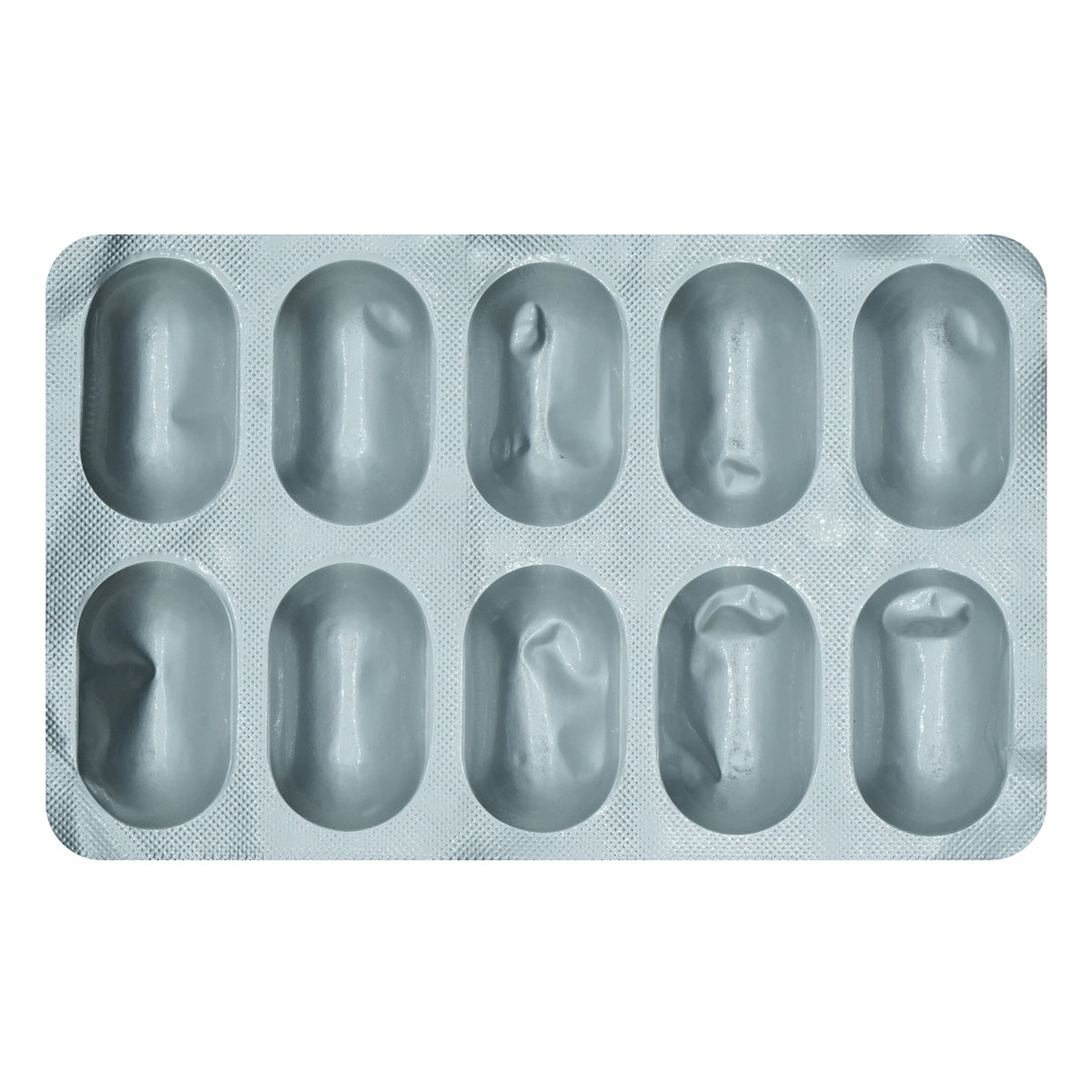


MRP ₹111
(Inclusive of all Taxes)
₹16.6 Cashback (15%)
Provide Delivery Location
Online payment accepted
 Prescription drug
Prescription drugWhats That
Composition :
Manufacturer/Marketer :
Consume Type :
Expires on or after :
Return Policy :
About Linanat-M 2.5 mg/1000 mg Tablet
Linanat-M 2.5 mg/1000 mg Tablet is a combination drug of Linagliptin (DPP4 inhibitors) and Metformin (Biguanides) belongs to the anti-diabetic class. Type 2 diabetes is a condition in which either the body stops producing enough insulin (the hormone which helps to decrease sugar levels in the blood) or resistance to insulin action. As a result, insulin is produced in large amounts but cannot act on the body's organs.
Linanat-M 2.5 mg/1000 mg Tablet contains Linagliptin (DPP4 inhibitors) and Metformin (Biguanide). Linagliptin is a dipeptidyl peptidase-4 (DPP-4) inhibitor that blocks the action of DPP-4, an enzyme that destroys the hormone incretin that helps the body produce more insulin only when required. It also reduces the amount of sugar produced by the liver when not needed. Metformin functions by lowering glucose production in the liver, delaying glucose absorption from the intestines and increasing the body's sensitivity to insulin. Together, it prevents blood glucose levels from rising to very high levels after meals.
Linanat-M 2.5 mg/1000 mg Tablet should be taken with food to avoid an upset stomach. Linanat-M 2.5 mg/1000 mg Tablet should be taken at the same time of the day each time for the best results. Your doctor will decide what dose should be taken for better advice, which can change quickly depending on your condition. The most common side effect of Linanat-M 2.5 mg/1000 mg Tablet is hypoglycemia (low blood glucose levels) characterized by dizziness, sweating, palpitations, hunger pangs, dry mouth, skin, etc. So to avoid hypoglycemia, you should not miss meals and should carry some form of sugar along with you. Other side effects include taste change, nausea, diarrhoea, stomach pain, headache, and upper respiratory symptoms.
Linanat-M 2.5 mg/1000 mg Tablet should not be stopped even if you feel better without consulting your doctor as the sugar level keeps changing. If you stop taking Linanat-M 2.5 mg/1000 mg Tablet abruptly, it may increase your sugar levels which could further increase the risk of eyesight loss (retinopathy), kidney (nephropathy), and nerve damage (neuropathy). Linanat-M 2.5 mg/1000 mg Tablet should not be taken if you have type 1 diabetes mellitus or severe kidney or liver disease. Please inform your doctor if you have heart disease or are planning to get pregnant or breastfeed.
Uses of Linanat-M 2.5 mg/1000 mg Tablet
Directions for Use
Key Benefits
Linanat-M 2.5 mg/1000 mg Tablet helps your pancreas produce more insulin, make effective insulin utilization, and decrease the excess sugar that your liver makes. It helps control the rise of blood sugar levels in your body after a meal. Besides this, it does not cause weight gain in prolonged use. Linanat-M 2.5 mg/1000 mg Tablet plays a vital role in controlling blood sugar levels and prevents serious complications of diabetes like eyesight loss (retinopathy), kidney (nephropathy), nerve damage (neuropathy), diabetic foot ulcer, and delayed wound healing.
Storage
Drug Warnings
Linanat-M 2.5 mg/1000 mg Tablet should not be used in patients with type 1 diabetes or with diabetic ketoacidosis. Some diabetic patients, while taking Linanat-M 2.5 mg/1000 mg Tablet , might develop a rare but serious condition called lactic acidosis. In this condition, there is too much lactic acid accumulated in the blood that can damage the working of your liver and kidney required for the elimination of excess lactic acid from the blood. Before you start taking Linanat-M 2.5 mg/1000 mg Tablet , tell your doctor if you’ve ever had pancreatitis (inflammation of the pancreas), kidney disease, and low vitamin B12 level. Linanat-M 2.5 mg/1000 mg Tablet , when used with insulin, may extremely lower the blood sugar level leading to hypoglycemia condition, which can be fatal. Your doctor may adjust the dose by lowering the dose of insulin or Linanat-M 2.5 mg/1000 mg Tablet in this case. A prolonged intake of Linanat-M 2.5 mg/1000 mg Tablet may lower your thyroid-stimulating hormone (TSH); hence, TSH's annual check-up is recommended. You may also develop a serious skin reaction known as bullous pemphigoid that requires immediate medical attention in rare cases. Tell your doctor if you will have a diagnostic test with an injection of dye or X-ray contrast agent. The use of Linanat-M 2.5 mg/1000 mg Tablet should be stopped for a short time before having an X-ray procedure.
Diet & Lifestyle Advise
- Fill your half plate with starchy veggies, a quarter with proteins, and a quarter with whole grain.
- Eat at regular intervals. Do not take a long gap between a meal or snack.
- Monitor your blood sugar level regularly, especially when there are lots of fluctuations.
- Invest at least 150 minutes of moderate-intensity physical activity or one hour and 15 minutes of high-intensity exercise weekly.
- Lose weight gradually to achieve a healthy body mass index (18.5 to 24.9).
- Replace refined carbohydrates containing whole-grain foods and increase the intake of fruits, veggies, and other fibre-enriched foods.
- Reduce saturated fat (or hidden fats) intake in food like chips, crisps, pastries, biscuits, and samosas. Choose omega-3 fatty acid-containing oils for daily cooking. For frying, you can use palm oil, mustard oil, groundnut oil, rice bran oil, and safflower oil.
- Do not take stress as it may elevate your blood sugar level. You can adopt stress management techniques like mindfulness to control stress-related blood sugar changes.
- Opt for low-fat dairy products (low-fat yoghurt, fat-free milk, cheese, etc.).
- Keep your blood pressure as normal (140/90) as possible as it reduces the risk of cardiovascular diseases in diabetes patients.
Side Effects of Linanat-M 2.5 mg/1000 mg Tablet
- Low blood sugar
- Runny nose
- Sore throat
- Upper lung infection
- Diarrhoea
- Nausea
- Vomiting
- Gas
- Stomach upset
- Indigestion,
- General weakness
- Headache
Habit Forming
Therapeutic Class
All Substitutes & Brand Comparisons
RX
Juslina-M 2.5/1000 Tablet 10's
Mankind Pharma Pvt Ltd
₹81.5
(₹7.34 per unit)
26% CHEAPERRX
Dynaglipt-LM 2.5/1000 Tablet 10's
Mankind Pharma Pvt Ltd
₹82
(₹7.38 per unit)
26% CHEAPERRX
Linero M 1000 Tablet 10's
Intas Pharmaceuticals Ltd
₹92.5
(₹8.33 per unit)
16% CHEAPER
Product Substitutes
FAQs
Linanat-M 2.5 mg/1000 mg Tablet contains Linagliptin (DPP4 inhibitors) and Metformin (Biguanide). Linagliptin is a dipeptidyl peptidase-4 (DPP-4) inhibitor that blocks the action of DPP-4, an enzyme that destroys the hormone incretin that helps the body produce more insulin only when required. It also reduces the amount of sugar produced by the liver when not needed. Metformin functions by lowering glucose production in the liver, delaying glucose absorption from the intestines and increasing the body's sensitivity to insulin. Together, it prevents blood glucose levels from rising to very high levels after meals.
Type 2 diabetes is a common form of diabetes in which the blood sugar-lowering hormone called insulin produced by the body does not function properly. Thus, the blood glucose level increases, and symptoms such as frequent urination, increased thirst, and increased hunger start. Diabetes, if left untreated or not treated properly, can cause long-term complications such as nerve damage, kidney damage, eye damage, foot problems, and poses a high risk of developing heart diseases.
Lactic acidosis is a rare but life-threatening condition when there is too much lactic acid built up in the bloodstream. Long term intake of Linanat-M 2.5 mg/1000 mg Tablet may lead to lactic acidosis when cells get deprived of oxygen levels. Lactic acidosis symptoms include a burning sensation of muscle, muscle ache, fast breathing, nausea, and stomach pain. Immediately contact the doctor about this complication.
Do not take excessive alcohol while taking Linanat-M 2.5 mg/1000 mg Tablet , as this may increase the risk of a life-threatening condition called lactic acidosis (too much lactic acid in the body).
No, Linanat-M 2.5 mg/1000 mg Tablet is only prescribed to treat type 2 diabetes, also called 'non-insulin-dependent diabetes.'
Linanat-M 2.5 mg/1000 mg Tablet should be given with caution in older adults as they are at an increased risk of hypoglycemia. Consult your doctor; dose adjustment may be required, and take Linanat-M 2.5 mg/1000 mg Tablet in dose as prescribed by your doctor.
If you feel that your blood sugar level is decreasing and you are feeling weak, immediately eat sugar candies or drink sugary beverages. It will help to balance the blood sugar level in your body. So, it is advisable to keep sugar candies with you.
Drug-Drug Interactions Checker List
- ASPIRIN
- CIPROFLOXACIN
- CIMETIDINE
- DIGOXIN
- AMLODIPINE
- TOPIRAMATE
- LAMOTRIGINE
- BUPROPION
- CEPHALEXIN
- RANOLAZINE
- DOLUTEGRAVIR
- VERAPAMIL
Disease/Condition Glossary
Type 2 diabetes is a condition where the body cannot make sufficient insulin, or the insulin that it makes doesn't work properly or is utilized by our body. This can cause high blood sugar levels (hyperglycemia). Type 2 diabetes symptoms include increased thirst, frequent urination at night, slow wound healing, increased hunger, fatigue, and blurred vision. There may be weight gain in some cases, while weight loss may be observed in rare cases. The complication of type 2 diabetes also includes neuropathy (nerve problems), nephropathy (kidney problems), and retinopathy (damaged retina of eyes or blindness), loss of limbs, sexual dysfunction, and increase the chance of heart attack or stroke.

Have a query?
Buy best Diabetics products by
Torrent Pharmaceuticals Ltd
Sun Pharmaceutical Industries Ltd
Eris Life Sciences Ltd
Intas Pharmaceuticals Ltd
Lupin Ltd
Micro Labs Ltd
Mankind Pharma Pvt Ltd
Lloyd Healthcare Pvt Ltd
Alkem Laboratories Ltd
Abbott India Ltd
Glenmark Pharmaceuticals Ltd
Cipla Ltd
Macleods Pharmaceuticals Ltd
Wockhardt Ltd
Dr Reddy's Laboratories Ltd
Primus Remedies Pvt Ltd
USV Pvt Ltd
Aristo Pharmaceuticals Pvt Ltd
Emcure Pharmaceuticals Ltd
Alembic Pharmaceuticals Ltd
Ipca Laboratories Ltd
La Renon Healthcare Pvt Ltd
Ajanta Pharma Ltd
Medley Pharmaceuticals Ltd
East West Pharma India Pvt Ltd
Elbrit Life Sciences Pvt Ltd
Corona Remedies Pvt Ltd
Hbc Life Sciences Pvt Ltd
Sinsan Pharmaceuticals Pvt Ltd
Ranmarc Labs
Mitoch Pharma Pvt Ltd
Zydus Healthcare Ltd
Sanofi India Ltd
Akumentis Healthcare Ltd
Fusion Health Care Pvt Ltd
Unison Pharmaceuticals Pvt Ltd
Jubilant Lifesciences Ltd
Novo Nordisk India Pvt Ltd
Tas Med India Pvt Ltd
Blue Cross Laboratories Pvt Ltd
Msn Laboratories Pvt Ltd
Eswar Therapeutics Pvt Ltd
Indoco Remedies Ltd
Q Check Pharmaceuticals
Alteus Biogenics Pvt Ltd
Anthem Bio Pharma
Franco Indian Pharmaceuticals Pvt Ltd
Systopic Laboratories Pvt Ltd
Panacea Biotec Ltd
Zydus Cadila
Biocon Ltd
Edoc Life Sciences Pvt Ltd
Koye Pharmaceuticals Pvt Ltd
Arkas Pharma Pvt Ltd
Diacardus Pharmacy Pvt Ltd
Elinor Pharmaceuticals (P) Ltd
Remedy Life Sciences Pvt Ltd
Saan Labs
Talent India Pvt Ltd
Jarun Pharmaceuticals Pvt Ltd
Capital Pharma
Shrrishti Health Care Products Pvt Ltd
FDC Ltd
Leeford Healthcare Ltd
Nirvana India Pvt Ltd
Elder Pharmaceuticals Ltd
Eli Lilly and Company (India) Pvt Ltd
Glynis Pharmaceuticals Pvt Ltd
Zuventus Healthcare Ltd
Arrient Healthcare Pvt Ltd
Cadomed Pharmaceuticals India Pvt Ltd
Orris Pharmaceuticals
Akesiss Pharma Pvt Ltd
Bal Pharma Ltd
Biochem Pharmaceutical Industries Ltd
Knoll Healthcare Pvt Ltd
Lippon Pharma Pvt Ltd
Morepen Laboratories Ltd
Neucure Lifesciences Pvt Ltd
Opsis Care Lifesciences Pvt Ltd
Wallace Pharmaceuticals Pvt Ltd
Acmedix Pharma Llp
Converge Biotech Pvt Ltd
Erinyle Pharma
Indiabulls Pharmaceuticals Pvt Ltd
Ozone Pharmaceuticals Ltd
Retra Life Science Pvt Ltd
Alvio Pharmaceuticals Pvt Ltd
Geneaid Pharmaceuticals
Heal (India) Laboratories Pvt Ltd
Olcare Laboratories Pvt Ltd
Vasu Organics Pvt Ltd
Kotak Life Sciences
Lakshya Life Sciences Pvt Ltd
Proqol Health Care Pvt Ltd
Sanz Pharmaceuticals
Daylon healthcare pvt Ltd
Mcronus Lifescience Pvt Ltd
Natco Pharma Ltd
Orsim Pharma
Alcohol
Safe if prescribed
It is best to avoid alcohol while taking Linanat-M 2.5 mg/1000 mg Tablet .
Pregnancy
Consult your doctor
Please consult your doctor for advice before using Linanat-M 2.5 mg/1000 mg Tablet .
Breast Feeding
Consult your doctor
Please consult your doctor for advice before using Linanat-M 2.5 mg/1000 mg Tablet .
Driving
Safe if prescribed
Drive only if you are physically stable and mentally focussed; if you experience drowsiness after taking these medications, you should not drive or operate any machinery or vehicles.
Liver
Consult your doctor
If u have or had a history or evidence of any liver-related diseases, please consult the doctor before taking medicine.
Kidney
Consult your doctor
If u have or had a history or evidence of any kidney-related diseases, please consult the doctor before taking medicine.
Children
Safe if prescribed
It is advisable to consult a doctor before using it.
Recommended for a 30-day course: 3 Strips






